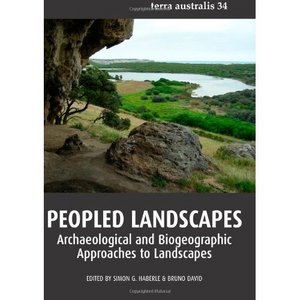Terrestrial engagements by terminal Lapita maritime specialists on the southern Papuan coast
McNiven, Ian J., David, Bruno, Aplin, Ken, Mialanes, Jerome, Asmussen, Brit, Ulm, Sean, Faulkner, Patrick, Rowe, Cassandra, and Richards, Thomas (2012) Terrestrial engagements by terminal Lapita maritime specialists on the southern Papuan coast. In: Haberle, Simon G., and David, Bruno, (eds.) Peopled Landscapes: archaeological and biogeographic approaches to landscapes. Terra Australis, 34 . ANU E Press, Canberra, ACT, Australia, pp. 121-156.
![[img]](https://researchonline.jcu.edu.au/19646/3.hassmallThumbnailVersion/19646_McNiven_et_al_2012_Cover.jpg)
|
Image (JPEG) (Book Cover)
- Cover Image
Download (48kB) |
|
|
PDF (Published Version)
- Published Version
Restricted to Repository staff only |
Abstract
Insights into Austronesian environmental impacts on the New Guinea mainland are negligible, as until now no conclusive evidence for Lapita settlement of mainland New Guinea had been found (e.g. Lilley 2008:79) and the period of concern reveals 'very little correlation with [anthropogenic] environmental change' (Hope and Haberle 2005:548). The recent excavation of Lapita and post-Lapita sites dating between 2900 and 2000 years ago at Caution Bay immediately northwest of Port Moresby, southern Papua New Guinea, negates the first conclusion of a purported absence of Lapita, and provides scope to challenge the second (McNiven et al. 2011). For 40 years, the accepted view has been that Austronesian colonisation of the southern Papuan coast took place around 2000 years ago by maritime peoples possessing a pottery tradition similar to but post-dating Lapita (David et al. in press). Ethnographically, the descendants of these peoples in the Port Moresby region practised a mixed economy of marine fishing and shellfishing, along with wallaby hunting across grasslands and savannah vegetation maintained by firing. While the antiquity of this process of anthropogenic landscape modification is unknown, it is considered to be no more than 2000 years ago. Here, we extend the known antiquity of mixed economic practices and possible anthropogenic landscape modification in the Port Moresby region using recent excavation results from Caution Bay, focusing on Edubu 1 site, dating from <2350 to 2650 cal BP. Our key aim is to establish a historical framework for pre-2000 cal BP human landscape engagements and transformations along the southern coast of mainland Papua New Guinea.
| Item ID: | 19646 |
|---|---|
| Item Type: | Book Chapter (Research - B1) |
| ISBN: | 9781921862717 |
| Keywords: | archaeology, Lapita, Pacific archaeology, coastal and island archaeology, Caution Bay, Papua New Guinea |
| Date Deposited: | 26 Apr 2012 07:17 |
| FoR Codes: | 21 HISTORY AND ARCHAEOLOGY > 2101 Archaeology > 210106 Archaeology of New Guinea and Pacific Islands (excl New Zealand) @ 100% |
| SEO Codes: | 95 CULTURAL UNDERSTANDING > 9505 Understanding Past Societies > 950599 Understanding Past Societies not elsewhere classified @ 100% |
| Downloads: |
Total: 566 Last 12 Months: 12 |
| More Statistics |



